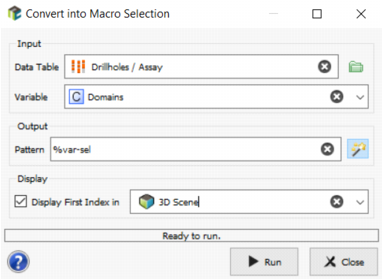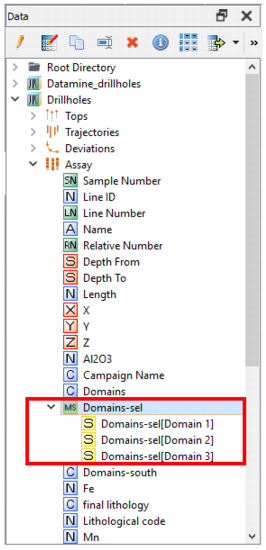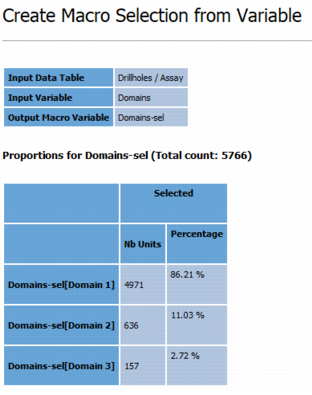Create Macro-selection from Variable
The Create Macro-selection from Variable functionality allows the creation of a macro-selection variable from any variable: numerical (integer or floating), categorical or alphanumerical.
The functionality is accessible from the Data Management ribbon or a right-click on a variable from the Data tree (Convert into Categorical Variable).
Macro-selection definition
A macro-selection is a selection variable which contains more than one value for each data point, each value being stored in one index of the macro-selection.
As a variable can be a selection, it is to say a 1-bit variable affecting the value of 1 for each sample that meet the requirements and the value of 0 to the samples that do not meet the criteria, a macro-variable can be a macro-selection, made of several individual selections, each selection being attached to one index of the macro-selection.
Macro-variables are recognized by their particular names (e.g.: Domains-sel[rich_ore] with “Domains-sel” the name of the macro-selection and “rich_ore” the name of a particular index of the macro-variable). A macro-selection may be created from simple criterion on a geological variable for example.
Note: Statistics on a macro-selection may be obtained using Statistics/Statistics application by selecting the macro-selection and the targeted index.
Contents
-
Input:
- Data Table: Click the directory icon next to Data Table to open a Data Selector and select the input data table where the variable you want to convert is located. The Data Table can also be dragged and dropped directly from the Data explorer.
- Variable: Select the variable on which you want to create the macro-selection. It can be numerical (integer or floating), categorical or alphanumerical. Undefined values will be kept undefined. One index will be created for each category or for each value.
-
Output: By default the name of the new output macro-selection variable will be the same as the input one with a suffix "-sel" (using the %var-sel pattern). You can modify this pattern to add a prefix or another suffix to the variable name.
The input variable values will be scanned and one index will be created for each distinct value (category or numerical value). The maximum number of indices is fixed to 500. If we detect more than 500 different values, an error message will be sent during the run.
- Display: The output macro-selection variable can be displayed in a 2D/3D view using the standard way (Drag & Drop from the Data Explorer to the Map/3D view) at the end of the run. However it is possible to automatically display the first index of the created output by ticking the Display toggle and selecting a scene. A layer will be created in the corresponding 2D/3D scene.
-
Click Run to create the new macro-selection variable in the same data table as the input variable.
Statistics of the number of samples and proportion belonging to each index are calculated and sent to the Application Messages window.




